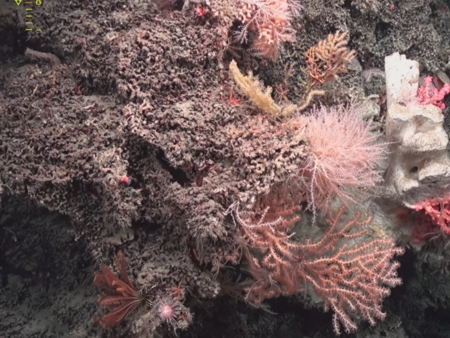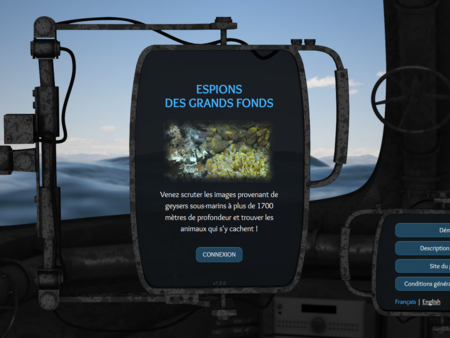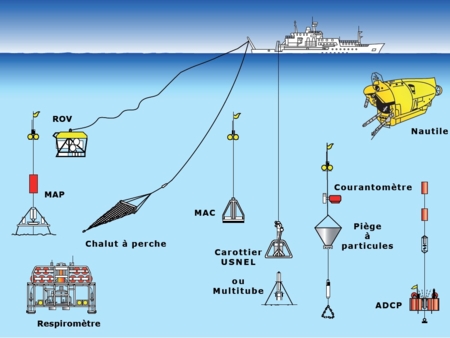Master 2 internship position at BEEP!
Our unit offers a Master 2 internship position from January to June 2023
Scientific context
Deep-sea hydrothermal fields are complex ecosystems subjected to high temperatures, pressures, large thermal and chemical gradients created be the mixing of hydrothermal fluid and surrounding water. Hydrothermal fluids are very hot, anoxic and rich in metals, particularly iron (Fe), which precipitate forming mineral around vents. It contains all the elements needed to the chemosynthesis, life support in absence of light. To date, the fluid emission defines the hydrothermal activity however, nothing
indicates that, once the fluid emission cease, chemical and biological activities cease too. In general, the microbial diversity in hydrothermal field, as the metabolic potential, are well known. Nevertheless, these data come mainly from active sites. To date, few studies focus on inactive or weakly active sites representing the major part of the deep-sea hydrothermal systems. In the ecosystem point of view, the changing of activity state also mark a changing of the dominant source of electron donors sustaining the chemosynthetic activity (Sylvan et al., 2012) and of the temperature and oxidation state, thus disturbing microbial communities. Due to the lack of studies focusing on inactive or weakly active sites, we do not have a precise idea of the biological activities and related metabolic potentials, especially iron (Fe) metabolic pathways.
In deep-sea hydrothermal ecosystems, Fe is found in its two oxidation states i.e. ferrous iron (Fe2+) and ferric iron (Fe3+) (Toner et al., 2012). The majority of Fe3+-reducing microorganisms identified are chemoorganotrophic, but some of them are able to grow in chemolithotrophic conditions. The bacteria isolated to date are mostly affiliated with the phyla of Proteobacteria, Deferribacteres and Firmicutes and the known archaea are mainly taxa belonging to the families Archaeoglobaceae and Pyrodictiaceae (Kashefi 2002; Roh et al., 2006; Slobodkina et al., 2009, 2012). Iron reduction metabolic pathways are based on MtrCAB and Omc gene clusters (Garber et al., 2020). Fe2+ is an energy source structuring chemolithoautotrophic microbial communities. In the current state of knowledge, the Fe2+-oxidizing taxa are mainly affiliated to the subphylum of Zetaproteobacteria (McAllister et al., 2020). To date, only 3 bacterial strains capable of Fe2+-oxidation have been isolated from deep-sea hydrothermal sources. These Fe-based metabolisms were also highlighted in hydrothermal field using biomarker genes as the cyc2 gene encoding for the Cyc2 Fe-oxidase and the mtrAB gene encoding for the MtrCAB complex involved in the Fe3+-reducing processus. (McAllister et al., 2021).
Study aims
While some microorganisms involved in the Fe-cycle have been characterized from deep-sea hydrothermal vents, we still do not have a comprehensive view of the metabolic pathways involved in the Fe-cycle at weakly active or active hydrothermal sites. To attempt to fill this gap, 4 hydrothermal sites were sampled (2 weakly active sites -MIR and Shimmering- and 2 inactive sites -Shinkai and Abyss-) at
the TAG hydrothermal vent field at the mid-Atlantic ridge (MAR) during the oceanographic cruise HERMINE2 in summer 2022. These samples will allow us to compare the microbial and functional diversity between l weakly active and inactive hydrothermal sites and according to physicochemical parameters and finally to do a focus on microorganisms involved in the Fe-cycle. To do so, after the study of the global microbial diversity using a metabarcoding approach, a metagenomic analysis will be performed, on these samples, to highlight the functional microbial diversity.
A focus on microbial actors of Fe-cycle will be done in order to identify (and complete) Fe metabolic pathways that are not yet fully understood.
The culturable diversity of microorganisms involved in Fe-cycle will also be investigated by performing enrichment cultures, isolations and physiological characterizations.
Internship aims
The main tasks of this Master 2 internship will be to perform:
- Metagenomic analyses: DNA extractions were performed by chemical lysis and libraries were prepared for Illumina HiSeq sequencing (subcontracted by Fasteris). During this internship, the sequences will be analyzed by meta-omic tools using Anvi’o.
- Microbial cultures: Enrichment cultures using Fe-based media in order to isolate new Fe3+- reducing and Fe2+-oxidizing strain will be performed. Depending on the progress of work (including prior to this internship), this culture part could be done to characterize a new microbial strain.
Candidate profile
Motivated student with training and interest in the fields of deep-sea microbiology, microbial taxonomic and functional diversity and microbial physiology. Curiosity and interest in meta-omics approaches and bioinformatics, culture experiments (anaerobic and
microaerophilic conditions).
Autonomy and rigor.
An experience in anaerobic cultures would be an advantage but is not essential.
Contacts
Please send a motivation letter, a CV and transcripts of records from the last 3 years to: Eva POUDER and Sophie MIESZKIN
References
GARBER, Arkadiy, NEALSON, Kenneth, OKAMOTO, Akihiro, MCALLISTER, Sean, CHAN, Clara, BARCO, Roman et MERINO, Nancy, 2020. FeGenie: A Comprehensive Tool for the Identification of Iron Genes and Iron Gene Neighborhoods in Genome and Metagenome Assemblies. Frontiers in Microbiology. 31 janvier 2020. Vol. 11, pp. 37.
Kashefi, Kazem, Dawn E. Holmes, Anna-Louise Reysenbach, et Derek R. Lovley. 2002. « Use of Fe(III) as an Electron Acceptor To Recover Previously Uncultured Hyperthermophiles: Isolation and Characterization of Geothermobacterium Ferrireducens Gen. Nov., Sp. Nov ». Applied and Environmental Microbiology 68 (4): 1735-42.
McAllister, Sean M., Shawn W. Polson, David A. Butterfield, Brian T. Glazer, Jason B. Sylvan, et Clara S. Chan. 2020. « Validating the Cyc2 Neutrophilic Iron Oxidation Pathway Using Meta-Omics of Zetaproteobacteria Iron Mats at Marine Hydrothermal Vents ». MSystems 5 (1).
McAllister, Sean M., Rebecca Vandzura, Jessica L. Keffer, Shawn W. Polson, et Clara S. Chan. 2021. « Aerobic and Anaerobic Iron Oxidizers Together Drive Denitrification and Carbon Cycling at Marine Iron-Rich Hydrothermal Vents ». The ISME Journal 15 (5): 1271-86.
Roh, Y., Gao, H., Vali, H., Kennedy, D. W., Yang, Z. K., Gao, W., ... & Zhou, J. (2006). Metal reduction and iron biomineralization by a psychrotolerant Fe (III)-reducing bacterium, Shewanella sp. strain PV-4. Applied and Environmental Microbiology, 72(5), 3236-3244.
Slobodkina, G. B., T. V. Kolganova, N. A. Chernyh, J. Querellou, E. A. Bonch-Osmolovskaya, et A. I.YR 2009 Slobodkin.
2009. « Deferribacter autotrophicus sp. nov., an iron(III)-reducing bacterium from a deep-sea hydrothermal vent ». International
Journal of Systematic and Evolutionary Microbiology 59 (6): 1508-12.
Slobodkina, G. B., A.-L. Reysenbach, A. N. Panteleeva, N. A. Kostrikina, I. D. Wagner, E. A. Bonch- Osmolovskaya, et A. I.YR 2012 Slobodkin. s. d. « Deferrisoma camini gen. nov., sp. nov., a moderately thermophilic, dissimilatory iron(III)-reducing bacterium from a deep-sea hydrothermal vent that forms a distinct phylogenetic branch in the Deltaproteobacteria ». International Journal of Systematic and Evolutionary Microbiology 62 (Pt_10): 2463-68.
Sylvan, J. B., Toner, B. M., and Edwards, K. J. (2012). Life and death of deep-sea vents: bacterial diversity and ecosystem succession on inactive hydrothermal sulfides. mBio 3, e279–e211. doi: 10.1128/mBio.00279-211 Toner, B. M., Marcus, M. A., Edwards, K. J., Rouxel, O., & German, C. R. (2012). Measuring the form of iron in hydrothermal plume particles. Oceanography, 25(1), 209-212.










